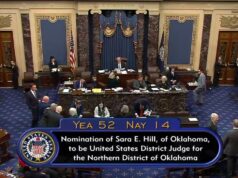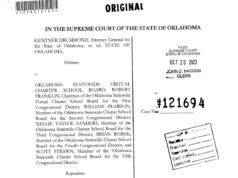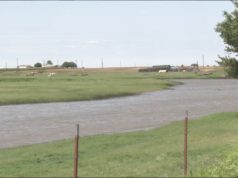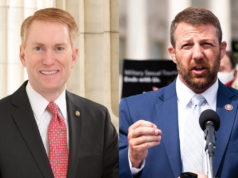
An online curriculum for studying the Tulsa Race Riot of 1921 was launched Feb. 20 at Douglass High School.
Tulsa Sen. Kevin Mathews (D-Tulsa) joined U.S. Sen. James Lankford (R-Oklahoma) as well as current and former African-American elected officials to outline how the curriculum provides one-day and five-day multimedia lesson plans.
Matthews is chairman of the 1921 Tulsa Race Riot Centennial Commission, and the curriculum is especially important as we approach the 100-year anniversary of what is now often called the massacre of 300 or more black Tulsans.
As Lankford said:
The commission’s focus is, when 2021 happens and that year occurs, the entire country for a moment is going to stop and is going to look at Oklahoma and is going to ask a very fair question: ‘What has changed in Oklahoma, with race, since 1921?’ That’s a reasonable question for the United States to ask of us, and it’s a question that we’d better have an answer for.
Lankford had hosted Matthews and Jamal Dyer, the commission’s project manager, at the National Museum of African American History and Culture in Washington, D.C. The riot is “prominently featured” in D.C., but, as Matthews notes, “We shouldn’t have to fly to Washington to learn about our own history.”
Everyone — not just teachers and students — should check out the lesson plans and follow the links to photographs, videos, oral history interviews and historical documents.
The difference between a ‘riot’ and a ‘massacre’
The lessons begin with the question of the difference between a “riot” and a “massacre.” Since the original, official account of the massacre claimed that “only” 39 people died, it wasn’t hard to pretend that the mass murder was merely a riot. For decades afterward, white and black Oklahomans were not taught that thousands of whites, aided by law enforcement officers and the National Guard, burned the Tulsa Greenwood area, which had previously been so prosperous that it was known as Black Wall Street.
The once-booming black community became the only mainland American community to be bombed from the air. About 6,000 blacks were detained, and an estimated 10,000 black Tulsans lost their homes, with many ending up in tent cities. (Novelist Rilla Askew and my students called the mass murder a “pogrom.”)
Placing Tulsa Race Riot of 1921 in context
The Tulsa killings were not the only racially motivated mass murders during that era. The curriculum links to a similar, post-World War I massacre of more than 100 blacks in Elaine, Arkansas, as well as the semi-successful defense of the “Elaine Twelve,” who had been sentenced to death. The offense committed by these black sharecroppers was joining the Progressive Farmers and Household Union in opposing the exploitation of cotton sharecroppers. As with Tulsans, their story was intertwined with the anti-Bolshevik “Red Scare” and the redirecting of war-time propaganda toward anti-labor violence.
And that leads us to some of the key themes of a 60 Minutes report that appears on the curriculum’s links. It includes grizzly photos of black murder victims and shows how some were turned into postcards. Clearly, Tulsa was a precursor to the ethnic cleansing of the late 20th century (which, of course, is another theme that students should study).
Stories from survivors who lived it
One of the curriculum’s links introduces Olivia Hooker, who, as a black 6-year-old, had known only white people as doing business with her father, bringing gifts and respectfully listening to her sister play Brahms on their piano (video above). Rioters smashed the piano and broke their Enrico Caruso records. Hooker adds, however, that fortunately they didn’t destroy the family’s record of “The Old Rugged Cross.”
The centenarian Hooker later recalled the day’s machine-gun fire and said, “It never occurred to me that ‘my country ’tis of thee’ would shoot at me.” In another linked video, the 106-year-old Bishop Otis Clark places the massacre in the context of other narratives ranging from Prohibition to the 1918 flu epidemic that killed tens of millions of people across the world.
Wrestle with history to understand the present
The study of these racist and propaganda-driven world-historical events is guaranteed to prompt class discussions comparing and contrasting those fearful times with the present. Schools should offer students the opportunity to go into as much depth as they want when studying the Tulsa massacre.
Why not also offer a project-based learning course on the Tulsa massacre? Students would have the time to research and analyze this Oklahoma tragedy in a global, historical and contemporary context. For students who choose it, such an in-depth learning for mastery could be transformative.
In the end, every generation must rewrite history from its own perspective. We have to wrestle with Tulsa’s contribution to crimes against humanity in order to understand the human condition as it plays out in the 21st century. After all, those who forget their history are doomed to repeat it.



















